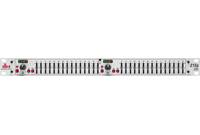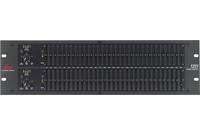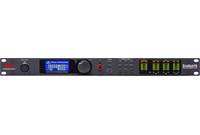About the Lexicon MX300

Legacy of innovation
Legacy of innovation
Lexicon pioneered the use of digital technology for reverb and was among the first companies to produce commercially available digital reverbs. Their innovations continued with multi-effects processors, hard-disk recording, and home theatre systems. This 35-year legacy of technology and achievement continues with the affordable, feature-rich MX series.
Dual processing, double duty
Lexicon's MX300 multi-effects processor lets you utilize two effects simultaneously with multiple routing options. You can choose from multiple reverb, delay, and modulated effects settings from Lexicon, along with compressor and de-esser options from dbx. You'll find five different routing options: Dual Mono, Cascade, Dual Stereo (Parallel), Mono Split and Stereo modes. 99 factory presets give you an immediate palette to choose from, and 99 user program slots allow you to create and save your own sounds.
Studio use
For studio use with VST- and Audio Unit-compatible DAWs, the MX200 features a USB interface that allows the MX300 to function as a 32-bit plug-in while operating as a dedicated hardware unit. You get all the benefits of Lexicon sonic expertise without bogging down your computer with plug-ins. You'll be able to control the MX300 from your graphical interface, plus create, edit, save, and load reverb and effects programs on your Mac or Windows computer.
Live shows
In performance, you can access programs through the main display with the Page Select knob, and the three assignable parameter knobs control the most important qualities of the selected effect without having to delve into complex menus. And ask any professional engineer – Lexicon processors are built tough to work night after night, shrugging off angry roadies, bad power, and the other inevitable abuses of life on the road.
Whether you're working live or in the studio, Lexicon's MX300 gives you world-class sounds and simplicity of operation. Find your sound with the power of Lexicon.
Highlights:
- stereo multi-effects unit with dual processors for simultaneous use of two effects
- 32 Lexicon reverbs and effects with adjustable parameters
- built-in dbx® compression and de-essing
- functions as a 32-bit plug-in without bogging down your computer
- in-depth editing of presets and programs from the Program Display Edit menus
- assignable Parameter knobs
- USB and MIDI interface implementation
- MX-Edit editor/librarian software included
- Dual Mono, Cascade, Dual Stereo (Parallel), Mono Split, and Stereo effect routing options
- tap tempo using the Tempo button for each processor
- bypass control buttons for individual effects or global bypass
- multi-function program changes with optional footswitch
Electronic features:
- balanced or unbalanced 1/4-inch TRS and XLR analog In/Out
- VST/Audio Unit plug-in capability via USB interface
- S/PDIF Digital In/Out (44.1/48kHz)
- frequency response: 10-20,000 kHz
- input level: +4dBu nominal, +24dBu maximum
- output level: +4 dBu or -10 dBV nominal (software adjustable), 24 dBu maximum
- 24-bit audio processor
General Features:
- weight: 3.75 lbs.
- dimensions: 19"W x 1-3/4"H x 6-3/8"D (7-1/4"D including knobs)
- warranty: 1 year
- MFR # MX300
What's in the box:
- MX300 Stereo Reverb Effects processor
- MX Edit/USB driver CD-ROM
- 4 Self-adhesive rubber bumpons
- Power cord
- User's Guide
- Warranty Card
Customer reviews for Lexicon MX300
Loading...
Loading reviews...
Average review:
5.0 out of 5 starsThanks for submitting your review
Customer photos
This review was collected as part of a promotion
Pros:
Cons:
More details on the Lexicon MX300

Product Research
Features
Overview: The Lexicon MX300 is a stereo reverb effects processor that can be used for live sound and home recording applications. You can choose from multiple reverbs and delays, as well as other effects, all from the front panel. The unit comes with powerful MX-Edit Editor/Librarian and VST/Audio Units software and a USB interface, which allows it to function as a "hardware plug-in" that functions with the software. The MX300 fits into a single rack space.
Dual Applications: The MX300 can be used effectively in the recording studio as well as for live performances:
- Studio Applications: In the studio, the MX300's USB interface lets you integrate the functionality of a complex effects processor into your computer-based recording. The included MX-Edit Editor/Librarian software lets you create, edit, compare, save, and load reverb and effects programs for use with the MX300 on your Windows or Mac computer. The included VST and Audio Unit software allows you to use the MX300 as a "hardware plug-in" to give you access to the reverbs and effects within your software recording projects.
- Live Applications: With the MX300 in your equipment rack, you can dial in the sound you want directly from the front panel. You can choose a program by rotating the large Program knob until the selected program number appears in the Program Display. The program loads when you press the Program button. To edit a program, you can make adjustments to it with the three adjustment knobs (A, B, C). The editing parameters for each knob are user assigned.
Reverbs and Effects: There are 33 total reverbs and effects that are available, right from the front panel:
| Reverbs | Delays | dbx Dynamics | Effects | |
|---|---|---|---|---|
| Small Hall Large Hall Small Plate Large Plate Room Chamber Gated Reverse | Vocal Hall Vocal Plate Drum Hall Drum Plate Ambience Studio Arena Spring | Studio Delay Digital Delay Tape Delay Pong Delay Mod Delay Reverse Delay 2-Tap Delay | Compressor De-Esser | Chorus Flanger Phaser Tremolo/Pan Rotary Vibrato Pitch Shift Detune |
Factory and User Presets: The MX300 has 99 Factory Presets and 99 User Presets that allow you to create your own effects. The Factory Programs are combinations of the 32 built-in reverbs and effects, while the 99 User Program locations provide a place for you to store your own reverb and effects combinations. The User Programs are identical to the Factory Programs until you change them. A two-character LED display indicates which of the programs is loaded, while an LED indicates whether the program is a Factory or User preset.
Routing Options: The MX300 offers five signal routing options, which allow you to use it as two independent effects processors, or combine the reverbs and effects for more complex sounds. You can choose from the following routing options:
- Dual Mono: The left and right input signals are sent through Effect 1 and Effect 2 independently. Each signal is then routed to its respective output, completely independent from the other.
- Cascade (Series): Left and right input signals are first sent through Effects 1, then through Effects 2, and routed as a stereo signals to their respective outputs.
-
Dual Stereo (Parallel): Left and right input signals are sent through both effects independently. The output signals of both Effects are then mixed together, and routed to both the outputs as a single stereo signal.
- Mono Split: Left input signal is sent through Effect 1, while the right input signal is sent through Effect 2. The output signals of both Effects are then mixed together and routed to both the outputs as a single stereo signal.
- Stereo Routing: When all you need is a single high-quality stereo effect path for the left and right channel signals, you can connect the processor in a simple stereo setup.
Parallel and Serial Connections: The MX300 can be used as both a Parallel and Serial effects processor:
- Parallel: A Parallel processor is connected by sending a copy of a signal into the effects device and the effected (or "wet") signal is returned to the mixer or amp, where it is blended together with the original unaffected (or "dry") signal. Parallel processing is typically used for reverbs, delays, and some modulated effects.
- Serial: A Serial processor is connected by sending the entire signal through the effects device and then to the amplifier or mixer. It is not blended with the unaffected signal. Serial processing is used for a compressor, de-esser, EQ, and modulated effects such as a tremolo, vibrato, and rotary.
Connections: The MX300 has the following rear panel connections:
- Footswitch: 1/4" TRS for connecting an optional 2-button footswitch (such as the Lexicon LEX-DFS) for independent bypass control of Effects 1 and Effects 2.
- MIDI: Two 5-pin MIDI DIN connections (In, Out/Thru)
- USB: Type B USB port for connecting to a computer using MX-Edit and MX300 plug-in window.
- S/PDIF: Two Coaxial Digital (RCA) jacks (In, Out); Digital In accepts 44.1kHz and 48kHz signals
- Analog Outputs: Two XLR female and two 1/4" balanced TRS
- Analog Inputs: Two XLR female and two 1/4" balanced TRS (XLR and 1/4" TRS cannot be used simultaneously)
Specifications
- Audio Inputs: Two XLR and two 1/4" TRS balanced or unbalanced
- Input Impedance: 50k Ohms balanced, 25k Ohms unbalanced
- Input Level: +4dBu Nominal, +20dBu Maximum
- A/D Conversion: 24-bit, 48kHz or 44.1kHz, 128x oversampling
- Audio Outputs: Two XLR and two 1/4" TRS balanced or unbalanced
- Output Impedance: 2k Ohms balanced, 1k Ohms unbalanced
- Output Level: +4dBu or -10dBV nominal (software adjustable), 24dBu Maximum
- Analog Performance:
- Frequency Response: 10 Hz - 20 kHz, +0 dB/-0.5 dB
- THD+N: <0.0019% 10 Hz - 20 kHz
- Dynamic Range: >109dB A-weighted
- Digital Input and Output: RCA (S/PDIF)
- Sample Rate: 44.1kHz or 48kHz
- Frequency Response: 10 Hz to 22 kHz (+/- 0.5dB @ 48kHz)
- Size: 1U
Loading...
Loading accessories...
Customer Q&A
Loading...
Loading articles...










